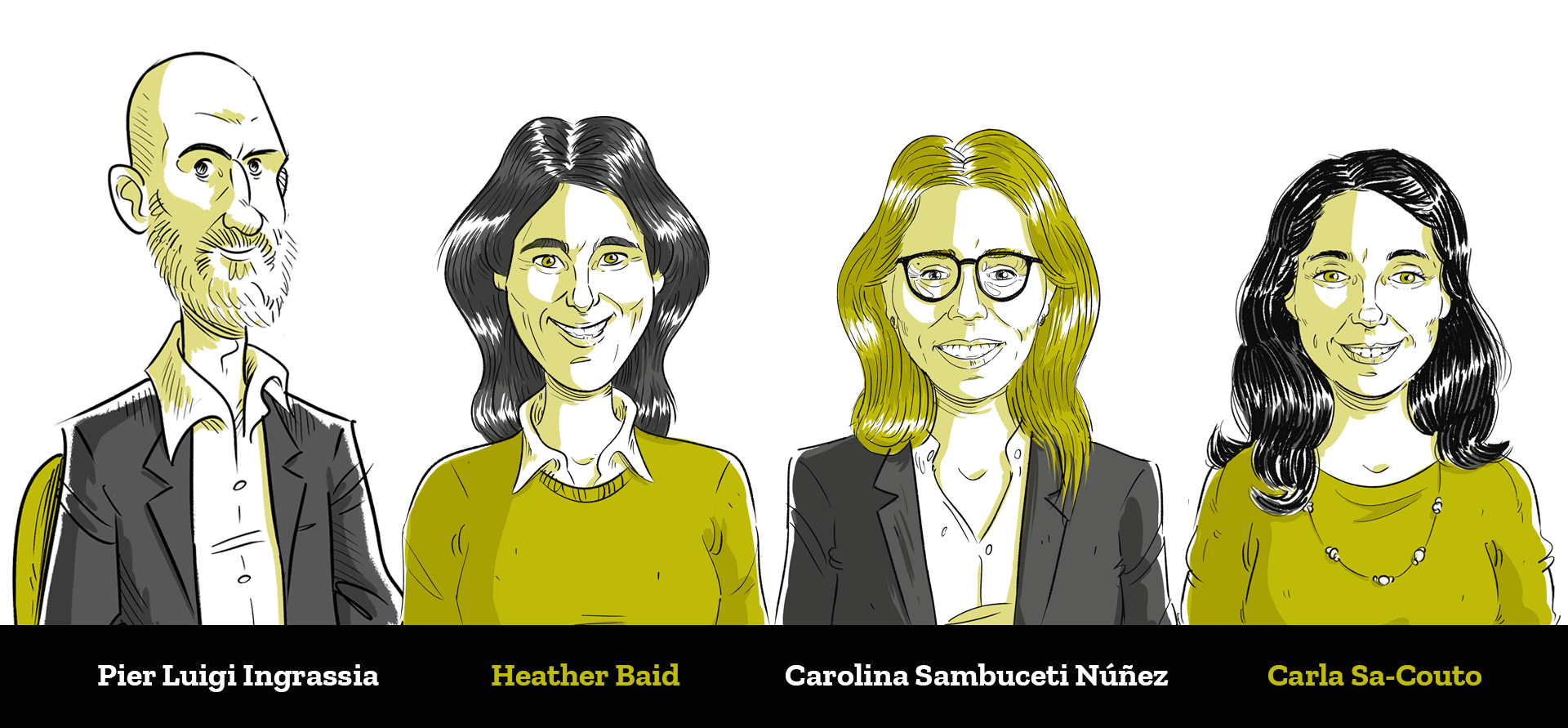Raising awareness toward a more sustainable simulation is critical. Our panelists discuss how to acquire the managerial skills to do so.
The debate
The World Health Organization (WHO) has identified climate change as “the greatest global health threat of the 21st century”. Therefore, also health simulationists, educators, organizations, industry bodies and leading experts in the simulation field have a moral duty to act in terms of taking responsibility for managing the planet and its resources.
Simulation is, in fact, a rapidly growing field, and this implies the need for sustainable and cost-effective methods to facilitate clinical simulation. Some scientific societies have established special interest groups on sustainability that reflect the commitment of our scientific community. As a recently published article showed, simulation centers are already implementing sustainable simulation activities, such as reusing consumables such as IV tubing, IV solution bags, and drug bags, and some are recycling some of them. But is there more to be done, and how? We asked our panelists.
Moderator: PierLuigi Ingrassia
Centro di Simulazione (CeSi), Centro Professionale Sociosanitario Lugano

Carolina Sambuceti Núñez
Emergency Nurse, Simulation Educator, Master of Education in Health Sciences. Currently serving as the Academic Director at the University of San Sebastián, Chile, she leads innovation in healthcare simulation.
Heather Baid
Heather Baid is a registered nurse specializing in intensive care who works as a Principal Lecturer at the University of Brighton. She has a keen interest in sustainability issues, including reducing the environmental footprint of healthcare practices with financial and social co-benefits.
Carla Sa-Couto
Clinical Simulation Educator and Research Lead at CINTESIS@RISE, Community Medicine, Information and Decision Sciences Department (MEDCIDS), Faculty of Medicine, University of Porto (FMUP);
Chair of the Steering Committee of the European Simulation Research Network (SiReN@SESAM);
Member of the Executive Committee and Conference Director of the Association for Simulated Practice in Healthcare (ASPiH)

Q1 Which are the main measures that we, as simulationists, should adopt to impact the environment on a global level?
Carolina Sambuceti Núñez: As educators in clinical simulation, we can take meaningful steps to mitigate our environmental impact. Clinical simulation, a potent educational methodology, necessitates resource management, from supplies to simulators and biomedical equipment, all of which have an environmental footprint. It is pertinent to design sustainable scenarios, harnessing virtual simulation to reduce the need for physical resources. Recycling and reusing simulators and supplies when safe to do so is advisable. Promoting energy conservation by selecting efficient consumption systems and opting for clean energy technologies is paramount. Minimizing waste generation by choosing reusable products and educating our students is essential. Furthermore, collaborating with simulation educators to share best practices and adopt more eco-friendly technologies is crucial. Finally, advocating for institutional policies that promote sustainability, including working with environmentally-friendly materials for simulation and simulation spaces, encouraging constructions with improved natural lighting and ventilation.
Heather Baid: The healthcare sector now strives to be more environmentally sustainable, with some countries, such as the UK, working towards net zero targets to minimise healthcare’s environmental footprint. Simulation-based education must catch up with this sustainability movement to mitigate ecological harm from a sense of planetary health stewardship and to maintain authentic simulation scenarios and settings. If hospitals and community settings are reducing their impact on global crisis issues such as climate change, biodiversity loss and water, air and land pollution, then simulation replicating this healthcare practice must follow suit. To improve environmental impact at a global level, all staff and learners involved with simulation need the capability, opportunity and motivation to change their behaviours for a widespread cultural shift, enabling simulation to reflect the principles of sustainable clinical practice (prevention, patient self-care, lean service delivery and low-carbon alternatives) focusing on a healthier approach to procurement, resource use and waste management.
Carla Sa-Couto: I believe that there are several simple measures we can adopt to make a positive environmental impact. Hereby some ideas:
- Develop and implement policies on the recycling of the pseudo-clinical waste generated by the simulation activities.
- Balance the need to create authenticity and immersive environments with the use of disposable personal protective equipment and real clinical material/equipment. Implement practices that minimize the use of disposable medical supplies in simulations and encourage the repurposing of simulation materials and equipment to minimize waste.
- Promote sustainable and accessible simulation-activities, such as virtual training sessions and telesimulations and teledebriefing (if educationally appropriate), to reduce the use of disposable supplies and equipment and the carbon footprint associated with travels.
- Integrate sustainability principles into simulation curricula to educate healthcare professionals about environmentally responsible practices, extending the impact beyond the simulation-activities.
Although our individual contribution and commitment is essential, these actions should be regulated and adopted at an institutional level, to promote adherence, a standardised implementation, and organisation accountability.
Q2 Which features should an environmentally accountable simulation center have?
HB: An environmentally accountable simulation center should have the physical setting and operationalised practices based on circular economy and systems thinking principles. A circular economy aims to prevent a ‘throw-away’ culture, particularly environmentally and financially costly clinical waste management, focusing on the ‘Rs’ of the resource cycle: reduce, reuse, repair, refurbish, remanufacture, repurpose, recycle and recover. Simulation practice can also use expired products or continue reusing clinical items that may not be suitable in a real-life healthcare situation involving patients but could still be used in simulated scenarios. Systems thinking considers the interconnectivity of all micro, meso and macro systems involved in a process to explore the wider context of resource use and all the people involved.
Simulation sustainability starts with resource utilization and waste management in the room but continues beyond
through clear communication and collaboration with others in estates, procurement and external stakeholders.
CSC: Ideally, an environmentally accountable healthcare simulation center should prioritize the implementation of several key features. These include a sustainable infrastructure (energy-efficient systems, as well as energy-saving equipment), utilize renewable energy sources, use eco-friendly simulation equipment, among others. The center should also implement waste reduction programs and promote recycling and repurposing to minimize the disposal of medical supplies and equipment. The center should promote sustainability education, with informative displays and materials to raise awareness among staff, students, and visitors. In essence,
an environmentally accountable simulation center integrates eco-conscious practices into its infrastructure, operations, and educational mission.
CSN: A responsible simulation center must adhere to a series of key characteristics to ensure its commitment to sustainability and environmental preservation. Firstly, it should rigorously measure and control its carbon footprint, assessing and reducing its environmental impact. Moreover, it should have clear policies from top management, setting sustainable goals and commitments. Recycling and proper waste management are crucial, reducing unnecessary waste generation and promoting reuse. Likewise, environmental education and awareness are essential for everyone involved in a simulation center, including students, educators, and collaborators. A simulation center that incorporates these features demonstrates its genuine commitment to environmental responsibility and serves as a model to promote sustainable practices in healthcare education and continuous training.

Q3 While adopting sustainable practices is good for the environment, do you think these practices can also help with the financial burden of sustaining healthcare simulation centers?
CSC: Definitely. While there is an initial investment associated with implementing a sustainable infrastructure, the long-term financial benefits often outweigh the upfront costs. This initial investment can be reduced with funding opportunities, as there are several governmental programmes that offer financial incentives to stimulate green building practices. On a longer-term, the energy-efficient systems can significantly reduce maintenance costs, reduced waste production, and recycling programs can result in cost savings on waste disposal. Additionally, sustainability initiatives can boost institutional reputation, attract funding and partnership opportunities, increase enrollment in training programs, which will generate additional revenue. In summary, sustainable practices not only benefit the environment but also have the potential to contribute to the financial health and resilience of healthcare simulation centers over time.
HB: Urgent change is needed for new working methods, reducing simulation’s impact on planetary health and bringing financial and social co-benefits. Waste reduction and appropriate segregation can significantly lower the monetary cost of buying disposable single-use items and decrease the amount of waste volume requiring incineration. Energy-saving measures can reduce the electricity or gas consumption required for lighting, heating and air conditioning. Financial sustainability is an important consideration because simulation approaches must be affordable for the daily functioning and longevity of the simulation department. Social sustainability considerations may be less obvious but are interconnected with environmental and financial sustainability. For example, simulationists can use a social-value model to guide ethical procurement, foster people satisfaction (in this case, staff and learners) and plan scenarios that address social determinants of health and the UN Sustainable Development Goals.
CSN: I believe sustainability encompasses both environmental and financial aspects. A simulation center that adopts a policy of appropriately recycling consumables not intended for real patients is already reducing its economic expenditure. If it prioritizes natural lighting and ventilation in its construction, it will incur lower energy costs. Additionally, by educating students, educators, and collaborators to cultivate a sustainable environmental culture, it will also have a long-term impact on savings.

Q4 In the last SIM Debate we discussed with our panelists whether and which sustainability elements should be integrated into center space design. What do you think about it?
CSN: Simulation-based education requires the management of spaces, supplies, simulators, biotechnology, and personnel. As mentioned earlier, the consideration of appropriate spaces, particularly those with natural lighting and ventilation, fosters sustainability. Another important element to consider is the use of clean energy, i.e., energy sources with low greenhouse gas emissions, with solar energy being one of them, as it is easily implementable today. Lastly, a crucial aspect to take into account is the judicious use of water. Employing sensors helps rationalize water consumption, and providing access to potable water sources for students, sim technicians, educators, and collaborators to refill their reusable bottles for personal use is a significant measure, not only for environmental reasons but also for improving overall health.
HB: New simulation spaces, or retrofitting established settings, provides an opportunity to design simulation centers which are fit for sustainability purposes. Multiple waste streams require space and clear signage to ensure appropriate waste segregation, encourage recycling and reduce incineration where possible for clinical items and packaging. Sustainable buildings can also be designed to include renewable energy sources, natural light where possible and responsible use of electricity, gas and water. Sustainable transport for staff and students is made easier by providing secure cycle storage, showering facilities, charging points for electric bicycles/cars and good public transport options. Green and blue spaces in healthcare are becoming popular for social prescribing initiatives (e.g. gardens and access to water for physical and mental health therapies) and promoting patient, family and staff well-being. Some simulation scenarios, therefore, could be delivered outside to authentically replicate these types of outdoor healthcare activities.
CSC: Sustainability elements should be embedded into center space design from the outset of the planning process. This approach ensures that sustainability is considered and incorporated throughout every stage of development. This means considering eco-friendly materials, energy-efficient systems/equipment, green technology and waste reduction strategies right from the conceptualization phase. From site selection and architectural design to technology infrastructure and interior planning, early integration of sustainability elements results in a healthcare simulation center that promotes environmental responsibility, and offers a healthy and efficient learning environment. By incorporating sustainability principles early in the design process, healthcare simulation centers can reduce their environmental footprint, reduce long-term operational costs, and create a healthier, more environmentally responsible learning environment for both trainees and staff.
Q5 In a recent commentary on health professions educational leadership in relation to planetary health emergencies, the term “eco-ethical leader” was coined and key characteristics of an “eco-ethical” leadership approach were identified (McKimm&McLean, Medical Teacher,2020, 42:8,855-860). What then should an “eco-ethical” simulation leader look like and do?
HB: Eco-ethical simulation leaders exemplify sustainability practices by promoting sustainable simulation top-down strategic policy and guidance and bottom-up championship of daily simulation practices. Leadership for sustainability does not need to follow a traditional hierarchy because sustainability initiatives require a collaborative approach from all stakeholders. The ‘leading’ can be done by simulation educators, technicians, students, industry representatives, and those working in estates, waste management and procurement. Leaders and team members can also draw from the familiar human factors’ principles of teamwork, communication, situation awareness and task management for more effective and efficient behaviour change, helping to ‘sustain’ sustainability.
Eco-ethical leadership and followership maintain quality simulation practices while sufficing with available resources to prevent putting planetary health and environmental sustainability at risk.
CSC: From my perspective, “eco-ethical” simulation leaders are visionary individuals who understand the critical link between healthcare and the environment. They actively promote sustainable practices within their simulation activities and integrate environmental awareness into healthcare education. This includes curriculum development that uses healthcare simulation to address global health emergencies. They collaborate with experts and community partners, fostering innovation in sustainable simulation technologies. They act as role models, inspiring colleagues and students/trainees to embrace eco-ethical practices and stay informed about environmental issues. Moreover, they engage in advocacy, promoting policies that align with sustainability goals. Ultimately, ‘eco-ethical’ simulation leaders strive to create a simulation environment that prepares healthcare professionals to address the urgent challenges of global health emergencies while ensuring ethical principles.
CSN: McKimm and McLean’s article presents an intriguing perspective for understanding the need for new leadership in Simulation-Based Education (SBE). As a leader in SBE, I consider it crucial to embrace an eco-ethical approach that aligns with the vision of sustainable leadership. This entails not only leading in healthcare professional training but also setting an example in terms of sustainability. Leading by example, through actions such as reducing, recycling, and reusing, being mindful of our carbon footprint, and actively advocating that SBE should propose solutions addressing environmental sustainability and planet preservation. I believe that an eco-ethical leadership in SBE is not only relevant but essential in addressing current and future environmental challenges in healthcare for our community.
Conclusion
The whole healthcare sector now strives to be more environmentally sustainable and simulation-based education must catch up with this sustainability movement to mitigate ecological harm. It is advisable to recycle and reuse simulators and supplies when it is safe to do so, or to design sustainable scenarios, taking advantage of virtual simulation to reduce the need for physical resources. New simulation spaces, or retrofitting established settings, provides an opportunity to design simulation centers which are fit for sustainability purposes. By incorporating sustainability principles early in the design process, such as eco-friendly materials, energy-efficient systems/equipment, green technology and waste reduction strategies, healthcare simulation centers can reduce their environmental footprint, reduce long-term operational costs, and create a healthier, more environmentally responsible learning environment for both trainees and staff.
READ ALSO






























